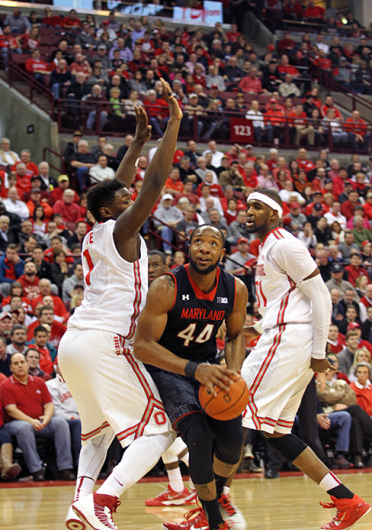
OSU freshman forward Jae’Sean Tate (1) guards Maryland senior guard Dez Wells (44) during a Jan. 29 game at the Schottenstein Center. OSU won, 80-56.
Credit: Samantha Hollingshead / Lantern photographer
As college basketball enters the final third of its regular season, it’s time to start evaluating teams and their worthiness of a bid to the NCAA tournament in March.
Sure, there is plenty of basketball to be played, but now that conference play is halfway over, it’s easy to see the big picture: The once-mighty Big Ten conference is failing to live up to expectations.
This trend was seen early in the out-of-conference schedule, when preseason ranked teams like Michigan State and Nebraska fell to Texas Southern and Incarnate Word, respectively. Or when Michigan fell to New Jersey Institute of Technology and Eastern Michigan. Or when Purdue fell to North Florida. These repeated losses to unheard-of schools were definitely not the trend most teams were hoping for heading into Big Ten play.
However, the first half of conference play has had plenty of interesting developments. Michigan, Michigan State and Purdue, despite bad out-of-conference losses, have combined for an 18-10 conference record. The Ohio State Buckeyes, who many argued were highly overrated after dominating most of their subpar competition, are tied for second in the conference after coming off back-to-back wins over ranked teams.
So what exactly is the problem with the Big Ten? Simply put: The conference has too many good teams, and not enough great teams.
In some of the latest bracketology polls, the 14-team conference only has four, five or six teams in the field of 68, and usually only one team with a top-four seed in any of the regions (Wisconsin). This is mainly caused by the incredible depth of the conference as teams struggle to separate from the pack. Twelfth-place Penn State and fifth-place Michigan State are only one game apart in overall record (14-8 and 15-7, respectively).
Looking at the traditional power conferences — Big 12, SEC, Pac 12, Big Ten and the ACC – the Big Ten has the best teams at the bottom of the standings, and potentially the weakest teams at the top. For example, the Big Ten and Big 12 (which has four fewer teams) both only have two teams with double-digit losses. Meanwhile, the other three power conferences have thirteen combined.
Most conferences have teams that are de facto wins for the elite members of the conference. In the Big Ten, Wisconsin’s only conference loss came at the hands of 10-13 Rutgers. The general lack of easy wins in conference play has been hurting the overall records of most of the teams in the conference, and also national perception of the conference.
So how does this affect OSU? In truth, what other teams do is completely out of the Buckeyes’ control. What OSU can do is keep its focus on each and every opponent and avoid any glaring upsets that could tarnish its tournament résumé. And assuming the Buckeyes get into the NCAA tournament in March, everyone can watch as the madness of college basketball destroys everything we thought we knew about the sport.


